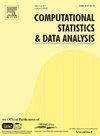基于群稀疏广义奇异值分解的分类数据稀疏因子分析
IF 1.6
3区 数学
Q3 COMPUTER SCIENCE, INTERDISCIPLINARY APPLICATIONS
引用次数: 0
摘要
对应分析、多重对应分析及其判别对应分析(即判别简单对应分析和判别多重对应分析)是分析多元分类数据的首选方法。在这些方法中,变量被整合到最优分量中,以线性组合的形式计算,其权重由广义奇异值分解(GSVD)获得,该分解集成了原始数据矩阵的行和列的特定度量约束。反过来,线性组合的权重被用来解释组件,当组件是1)成对正交和2)当权重值或大或小但不是中间值时,这种解释很容易-一种称为简单或稀疏结构的配置。为了获得这种简单的配置,将GSVD所解决的优化问题扩展到包含实现组件正交性和稀疏权值的新约束。由于多对应分析通过数据矩阵中的一组二进制列来表示定性变量,因此为了使表示一个定性变量的整个列集稀疏化,在优化问题中增加了额外的组约束。这种方法被称为群稀疏GSVD (gsGSVD),它通过迭代投影方案将这些约束集成到子空间的交叉点上,其中每个子空间实现一个特定的约束。详细描述了该算法,并展示了如何将其适应于简单和多对应分析的稀疏化(以及它们的质心判别分析版本)。通过对四个不同数据集的分析来说明该算法,每个数据集都说明了一种特定的基于ca的方法的稀疏化。本文章由计算机程序翻译,如有差异,请以英文原文为准。
Sparse factor analysis for categorical data with the group-sparse generalized singular value decomposition
Correspondence analysis, multiple correspondence analysis, and their discriminant counterparts (i.e., discriminant simple correspondence analysis and discriminant multiple correspondence analysis) are methods of choice for analyzing multivariate categorical data. In these methods, variables are integrated into optimal components computed as linear combinations whose weights are obtained from a generalized singular value decomposition (GSVD) that integrates specific metric constraints on the rows and columns of the original data matrix. The weights of the linear combinations are, in turn, used to interpret the components, and this interpretation is facilitated when components are 1) pairwise orthogonal and 2) when the values of the weights are either large or small but not intermediate—a configuration called a simple or a sparse structure. To obtain such simple configurations, the optimization problem solved by the GSVD is extended to include new constraints that implement component orthogonality and sparse weights. Because multiple correspondence analysis represents qualitative variables by a set of binary columns in the data matrix, an additional group constraint is added to the optimization problem in order to sparsify the whole set of columns representing one qualitative variable. This method—called group-sparse GSVD (gsGSVD)—integrates these constraints in a new algorithm via an iterative projection scheme onto the intersection of subspaces where each subspace implements a specific constraint. This algorithm is described in details, and we show how it can be adapted to the sparsification of simple and multiple correspondence analysis (as well as their barycentric discriminant analysis versions). This algorithm is illustrated with the analysis of four different data sets—each illustrating the sparsification of a particular CA-based method.
求助全文
通过发布文献求助,成功后即可免费获取论文全文。
去求助
来源期刊

Computational Statistics & Data Analysis
数学-计算机:跨学科应用
CiteScore
3.70
自引率
5.60%
发文量
167
审稿时长
60 days
期刊介绍:
Computational Statistics and Data Analysis (CSDA), an Official Publication of the network Computational and Methodological Statistics (CMStatistics) and of the International Association for Statistical Computing (IASC), is an international journal dedicated to the dissemination of methodological research and applications in the areas of computational statistics and data analysis. The journal consists of four refereed sections which are divided into the following subject areas:
I) Computational Statistics - Manuscripts dealing with: 1) the explicit impact of computers on statistical methodology (e.g., Bayesian computing, bioinformatics,computer graphics, computer intensive inferential methods, data exploration, data mining, expert systems, heuristics, knowledge based systems, machine learning, neural networks, numerical and optimization methods, parallel computing, statistical databases, statistical systems), and 2) the development, evaluation and validation of statistical software and algorithms. Software and algorithms can be submitted with manuscripts and will be stored together with the online article.
II) Statistical Methodology for Data Analysis - Manuscripts dealing with novel and original data analytical strategies and methodologies applied in biostatistics (design and analytic methods for clinical trials, epidemiological studies, statistical genetics, or genetic/environmental interactions), chemometrics, classification, data exploration, density estimation, design of experiments, environmetrics, education, image analysis, marketing, model free data exploration, pattern recognition, psychometrics, statistical physics, image processing, robust procedures.
[...]
III) Special Applications - [...]
IV) Annals of Statistical Data Science [...]
 求助内容:
求助内容: 应助结果提醒方式:
应助结果提醒方式:


